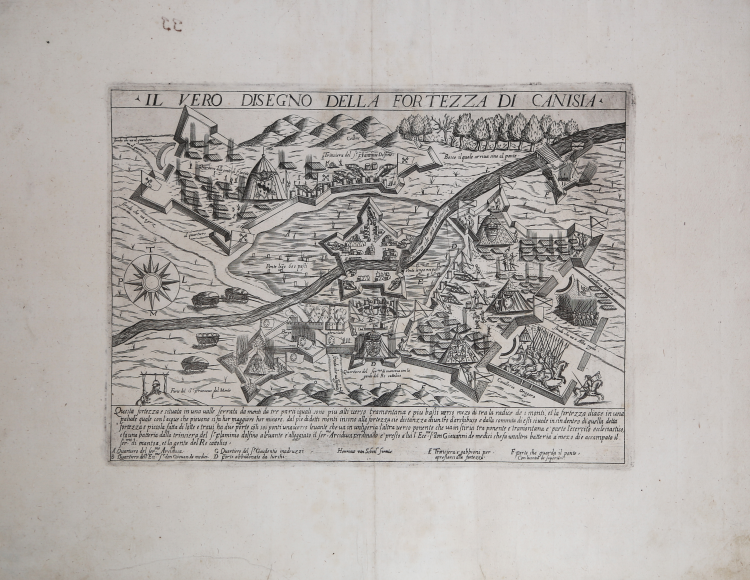




| Reference: | S35101 |
| Author | Giovanni ORLANDI |
| Year: | 1602 ca. |
| Zone: | Nagykanizsa |
| Printed: | Rome |
| Measures: | 352 x 259 mm |



| Reference: | S35101 |
| Author | Giovanni ORLANDI |
| Year: | 1602 ca. |
| Zone: | Nagykanizsa |
| Printed: | Rome |
| Measures: | 352 x 259 mm |
IL VERO DISEGNO DELLA FORTEZZA DI CANISIA
Questa foretzza e situata in una valle serrata da monti da tre parti i quali sono piu alti vero tramontana e piu bassi verso mezo di tra l radice de i monti, et la fortezza diace in una palude quale con l’acque che piovono si fa hor maggiore hor minore dalmpie di detti monti insino alla fortezza cie distanzza diuntro d’archibuso e dalla sommita di essi si vede dentro di quella detta fortezza e piccola fatta di lotte e travi ha due porte coli soi ponti una verso levante che va in unhgeria ‘altra verso ponente che va in Stiria tra ponente e tramontana e posto l’esercito eclesiastico, e fa una batterua della trinciera del S.r plaminio dolfino alevante e alloggiato il Ser.mo Arciduca Ferdina[n]do e presso a lui l’Ecc.mo S.r don Giovanni de medici che fa unaltra batteria a mezo die accampato il Ser.mo di mantoa et la gente del Re cattolico.
Example of the second state of two, with the imprint: Henricus van Schoel formis.
Etching with engraving, printed on contemporary laid paper with “Fleur-de-lys in circle under crown” (cf. Woodward 103-106), with margins, good condition. VERY RARE.
The perspective plan shows the fortress of Nagykanizsa (it. Canisia), during the unsuccessful siege of reconquest ,attempted in early October 1601 by imperial and papal troops, after the city in November 1600 had fallen into the hands of the Turks. The expedition, however, failed, and the city will be regained only in 1690. Howexplained in the caption, the fortress stood in a marshy valley enclosed by mountains on three sides. The project of thePentagonal bastion, regular bastion, once again is due to the Italian Pietro Ferrabosco (1568), whilethe works were followed by Giovanni Arconati (1574-1578), Antonio Albertini and Bernardo Magno (1577). Thereplan shows the arrangement of the besieging troops, with each encampment marked by the emblemof the relative general: in the north were the troops led by Flaminio Delfini who, after the death of GianFrancesco Aldobrandini, which took place on 17 September 1601, was appointed commander of the papal troops; tothe area of the Archduke Ferdinand of Austria, that of Don Giovanni de 'Medici and further south, thetroops of Vincenzo Gonzaga. Around the middle of November the retreat was decided by the archduke. The slab, therefore, it was built after 17 September 1601 - not appearing the name of Aldodrandini as general Pontifical, and before the end of the siege.
This Orlandi map follows the typology of the one published in Augsburg from Dominus Custos, which Béla considers earlier, and in turn based, albeit with modifications, on the prototype recorded by Georg Keller and published in Frankfurt. However, it seems more likely that Orlandi copied the map published by Donato Rascicotti (cf. Bifolco-Ronca Tav. 537).
The plate was published the first by Giovanni Orlandi in 1602. The van Shoel's edition, without date, probably was published after 1614, when Orlandi sold his plates to the Flemish editor.
Literature: Bifolco-Ronca, Cartografia e Topografia Italiana del XVI secolo, Catalogo ragionato delle opera a stampa (2018), tav. 538, II/II; Ganado (1994): VI, p. 200, n. 38; Szalai Bela (2001): p. 94, nn. 1601/5 e 1601/3, tav. 169; Szalai-Szantai (2006): nn. 1601/5 e 1601/3, tav. 144..
Known examples: 1°: Fano, Federiciana; Malta, National Library; Roma, Biblioteca Apostolica Vaticana.
2°: Roma, Istituto Central per la Grafica (2).
|
Bifolco-Ronca, Cartografia e Topografia Italiana del XVI secolo, Catalogo ragionato delle opera a stampa (2018), tav. 538, II/II;
|
Giovanni ORLANDI (Attivo 1590 -1640)
|
Engraver, printer and print publisher from Bologna. Active in Rome from 1590 until 1613and then in Naples. His shop in Rome was at the Pasquino. He also seems to have been a dealer in drawings. In 1608 he was employing a printer,G.B. Ranieri.
He bought existing plates from Johannes Statius, Cherubino Alberti and Nicolas van Aelst.
Orlandi acquired plates of Vignola’s Regola delli Cinque Ordini d’Architettura which he published in 1602. Orlandi does not seem to have built up a stock of plates, but having taken from them what he could, sold them on. Van Aelst bought plates from Orlandi, as for example the Twelve Profets and Ten Sibyls of Schiaminossi.
In 1609 Orlandi is reported as regretting having sold four small etched plates by Annibale Carracci, after having taken 400 impressions from them. He published work by Tempesta.
|
|
Bifolco-Ronca, Cartografia e Topografia Italiana del XVI secolo, Catalogo ragionato delle opera a stampa (2018), tav. 538, II/II;
|
Giovanni ORLANDI (Attivo 1590 -1640)
|
Engraver, printer and print publisher from Bologna. Active in Rome from 1590 until 1613and then in Naples. His shop in Rome was at the Pasquino. He also seems to have been a dealer in drawings. In 1608 he was employing a printer,G.B. Ranieri.
He bought existing plates from Johannes Statius, Cherubino Alberti and Nicolas van Aelst.
Orlandi acquired plates of Vignola’s Regola delli Cinque Ordini d’Architettura which he published in 1602. Orlandi does not seem to have built up a stock of plates, but having taken from them what he could, sold them on. Van Aelst bought plates from Orlandi, as for example the Twelve Profets and Ten Sibyls of Schiaminossi.
In 1609 Orlandi is reported as regretting having sold four small etched plates by Annibale Carracci, after having taken 400 impressions from them. He published work by Tempesta.
|